6 Days Exploration of Western Korea




This tour begins in western Korea and ends on Jeju Island. The “Exploration of Western Korea Tour” takes you off the beaten path to places like Chungchungnam-do, Jeolla-do and the South Sea to see historical sites, experience traditional culture, folk customs and Korean opera (Pansori), as well as beautiful national parks and the breathtaking coastline with numerous islets of the Southern Archipelago. You will love the variety of delicious traditional dishes and fresh seafood this part of the country has to offer. Jeju Island is a volcanic island and its lava tubes have been registered by UNESCO as a natural World Heritage Site. On Jeju Island scenic beaches, waterfalls, cliffs and caves lie in harmony and together with the mild weather make Jeju Island an ideal tourist site.
* Minimum 2 persons are guaranteed to depart every Thursday.

Day 1
Seoul > Hwaseong > Buyeo > Jeonju
 You will meet your tour guide in front of the main gate of Sinsegye Department Store located near Gangnam (Banpo) Express Bus Terminal and then head for Suwon. The first stop on the tour today is Hwaseong Fortress, a UNESCO World cultural Heritage Site, located in Suwon. An interesting point to note about the Fortress is that it was planned and built using concepts of practical science. Next you will go to Buyeo, the ancient capital of the Baekjae Dynasty (18 BC - 660 AD), where you will visit Goransa Temple and Nakhwaam Bluff. Here at the bluff is where 3,000 court ladies of Baekjae plunged into the river to avoid being captured and dishonored when an invading enemy breached the castle on the last day of the Kingdom. Optional tour: Cruise ($6 USD).
You will meet your tour guide in front of the main gate of Sinsegye Department Store located near Gangnam (Banpo) Express Bus Terminal and then head for Suwon. The first stop on the tour today is Hwaseong Fortress, a UNESCO World cultural Heritage Site, located in Suwon. An interesting point to note about the Fortress is that it was planned and built using concepts of practical science. Next you will go to Buyeo, the ancient capital of the Baekjae Dynasty (18 BC - 660 AD), where you will visit Goransa Temple and Nakhwaam Bluff. Here at the bluff is where 3,000 court ladies of Baekjae plunged into the river to avoid being captured and dishonored when an invading enemy breached the castle on the last day of the Kingdom. Optional tour: Cruise ($6 USD). Day 2
Jeonju > Jinan > Namwon > Sunchang > Gwangju

Today you will begin the tour in Jinan and visit the breathtaking Tapsa Temple complex at Mt. Maisan National Park. At the complex you will see unusual yet beautiful stone pagodas in the shape of conical pyramids. What is incredible about these pagodas is that they were built by hand nearly 100 years ago without the use of mortar or any binding agent. They were so solidly constructed just by placing local stones together that no matter how bad the weather is, even during storms, the pagodas do not fall. It is said that over 120 of these pagodas were originally built, but only about 80 remain today. Interestingly, in the wintertime it gets so cold at Mt. Maisan that if you set a bowl of water outside, the water will freeze into a spike reaching for the sky.

The next stop on the tour is Namwon, a city built by Hwanghee Jeongseung in 1419 during the reign of Joseon Dynasty's King Sejong and encompassed by breathtaking scenery. Gwanghallu, a pavilion, in this city is famous for being the place where Lee Mong-ryong and Chunghyang first met each other and fell in love. A portrait of Chunghyang is housed in Chunghyangsa Temple, built in the 1920s.

You will continue to Sunchang Gochujang (Red Pepper Paste) Folk Village, well-known for its production of outstanding deep sweet and savory red pepper paste. The secret of the paste’s delightful taste is found in Meju (soybean malt). The soybean malt is made by mixing soybeans and sticky rice, which is rich in gluten. The sun-dried hot peppers are grown in the local highlands and are characterized by their extremely spicy taste. The final stop on the tour today is Damyang Bamboo Theme Park, where you can see an impressive bamboo forest surrounded by picturesque scenery.
Gwangju Prado Hotel or similar
Meal:
Breakfast, Lunch
Day 3
Kwangju > Haenam > Wando > Nakaneupseong > Suncheon
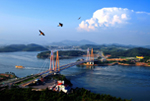
Today you will travel to Haenam located at the end of the Korean peninsula where you will see Mt. Duryun at the edge of the Baekdu Mountains. Optional tour: Take a cable car up to the top of Mt. Duryun, 638m above sea level, for breathtaking views of the sea below.
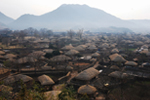
Next you will go to Wando Island and view Sinji Island's long beach through bridges before reaching Boseong Tea Plantation, a beautiful green field where you can enjoy the tea plants’ pleasant fragrance. The final stop on today’s tour is Nakaneupseoung Folk Village. The village was built 500 years ago and is well-preserved with 108 families still living within its confines.
Sunchon Royal Hotel or similar
Meal:
Breakfast, Lunch
Day 4
Jinju > Busan > Jeju Island
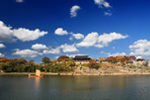
The first stop on the tour today is Jinjuseong Castle, a 1,760-square-meter stone castle and the sacred ground of the Jinju battles. Originally the castle was built of mud, but it was rebuilt with stones in 1379 by King Woo of the Goryeo Dynasty to withstand the frequent invasion of sea marauders. During the Japanese invasion of Korea in 1592, General Kim Si-min defeated Japanese forces at this castle, one of three great victories during the war. In 1593, during the second Jinjuseong Battle, approximately 70,000 militia corps and government troops resisted the invading Japanese and died gloriously for their country. Next you will visit Nongye Shrine, named after a Korean geisha who died with a Japanese enemy general by embracing him and leaping into a river, and Chokseokru Pavilion in Jinju city.

After, you will transfer to Mt. Mireuk on Mireuk Island within the limits of the city of Tongyeong. On Mireuk Island you will see a valley through which a river flows down between a heavily wooded forest as well as rock caves with various strange rock formations. Optional tour: Cable car to the top of Mt. Mireuk to view the panoramic scene of the archipelago water ways below ($15 USD).

You will continue to Gimhae Airport in Busan for the flight to Jeju Island, the premier tourist destination in Korea because of its stunning natural scenery and superior tourist amenities. Your tour guide will meet you at the airport on Jeju Island. Jeju Island is a volcanic island and its lava tubes have been registered by UNESCO as a natural World Heritage Site. On Jeju Island scenic beaches, waterfalls, cliffs and caves lie in harmony and together with the mild weather makes Jeju Island an even more ideal tourist site.
More Information about Jeju Volcanic Island
More Information about Jeju Volcanic Island
Day 5
Jeju Volcanic Island
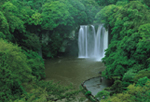
You will begin today's tour by visiting Cheonjiyeon Waterfall, a three-tiered waterfall surrounded by lush foliage and also named the Pond of God. To the east there is a cave where cold water pours from the ceiling to create a waterfall. The water from the first waterfall becomes the second and third waterfalls and then flows into the sea. A legend about seven nymphs and a mountain god is tied to this wondrous place. The next stop is Gyulimseong, a citrus farm and museum with nearly 1000 wild plants and flowers growing in the basalt volcanic rock. Optional tour: A pleasure boat cruise in Seogwipo where you can enjoy the view from both above and below the sea ($12 USD). Many isolated and unexplored regions including islands and Seogwipo’s beautiful coastal scenery are viewed from the boat.
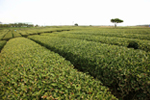
Next you will visit O’Sulloc Tea House, a museum dedicated to green tea. The museum is the shape of a green tea cup, seeking to harmonize the cultures of the West and East and past traditions with the modern world.
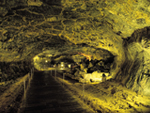
You will continue to Hallim Park where you can explore Palm Tree Road, Jeju Stone and Bonsai Garden, the Water Garden, the Subtropical Botanic Garden and much more. The most famous tourist sites in Hallim Park are Hyeopjaegul and Ssangyonggul, the only two-dimensional caves in the world. In addition, a folk village, children's amusement park and outdoor resort facilities make Hallim Park enjoyable for both children and adults.

The next place you will visit is Yongmeori (Dragon Head) Shore – an impressive and beautiful oceanside promenade of soaring, weather-blown cliffs. Note that Yongmeori closes during very high seas. If this is the case during your visit, you will visit Sangbanggbulsa, a natural cave overlooking the ocean. Optional tour: Traditional dyeing experience using natural dyes and fibers ($10 USD).
Day 6
Jeju Volcanic Island
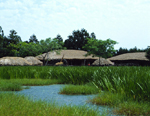
After having breakfast at your hotel, you will check out and begin the day’s tour at Dokkaebi Road (Mysterious Road) – a road on which your vehicle will roll uphill if the vehicle is parked and in neutral. Next you will visit the Amethyst Factory, where you can see and feel excellent quality Korean amethyst stones. You will continue to Seonnyeo (nymph) and Namuggun (woodcutter) Theme Park, comprised of a folk village, old market street, old shanty house village, an agricultural museum displaying old farming utensils and an embroidery museum. Seongeup Folk Village is a wonderful example of Korea’s preserved cultural traditions, including residential houses, Confucian shrine and schools, ancient government offices, stone statues and monuments and fortress ruins.

Here you can also experience folk plays, native foods, local craftsmanship and local dialects that have been handed down through generations. When you explore this area, you like you have traveled back in time. After lunch, you will visit Seongsan Ilchulbong (Sunrise Peak) Tuff Cone, and then transfer to Jeju International Airport for your flight to your next destination.
Meal:
Breakfast, Lunch
* Photos courtesy of Korea Tourism Organization.
* The cost of the tour includes: Hotels / Guides / Transportation / Meals (as indicated in the itinerary) / Entrance fees.
* The cost of the tour does not include: International and domestic flights / Travel insurance / Optional tours / Dinner / Tips for the guide and driver ($10 USD per person per day is recommended) / Personal expenses.
Terms and Conditions
- Prices may vary due to availability. We reserve the right to make price adjustments without prior notice.
- Although it is our strong intention to follow the agreed itinerary, there will be a degree of flexibility in consideration of various operational factors including flight delays or bad weather.
- Please refer to our Terms and Conditions before you make your reservation.
- Although it is our strong intention to follow the agreed itinerary, there will be a degree of flexibility in consideration of various operational factors including flight delays or bad weather.
- Please refer to our Terms and Conditions before you make your reservation.

